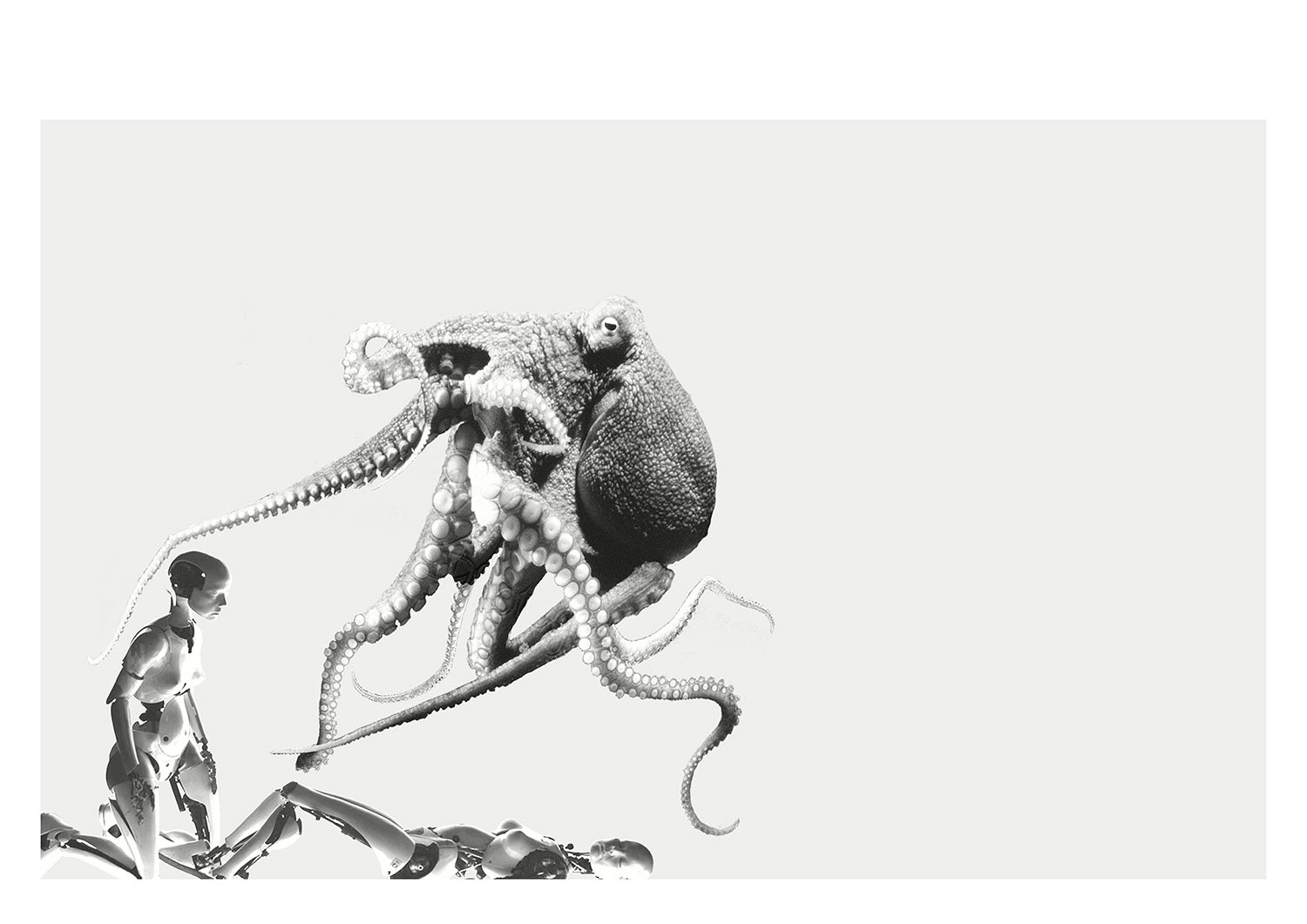- Login
Critical Spatial Practice






‘…it’s just begun. Six billion acres
under time, under stress and stretches
of content. Reserved for a duration.
Blue-green grid of constant revolution.’
Susan Barba, ‘Exhibit 1,’ Geode, (Black Sparrow Press, 2020).
Written loosely from the non-human perspective of a white-spotted octopus, Moonfuture is a visual-research essay and fictional story that explores the spatial implications of human actions. The story touches on extractivism and society’s addiction to images. The reader travels to real and invented spaces built from images that form six thematic collages focused on time, intelligence, mobility, image, technology, and nature, collectively titled Storied Spaces.
For each collage in Storied Spaces, a two-image composition values precision in visual narration and the incomplete as a form of inclusivity. The collages are framed in a grey space where the images coexist, and they can take off and land. It functions like a portal or airport for the images. This notion situates the images directly in relation to Hito Steyerl’s ideas on images as circulatory networks of energy and matter.(Steyerl, 2013) Images are powerful, they possess an ability to travel and influence people, environments, and socio-political systems. Steyerl remarks, ‘around 1989, television images started walking through screens, right into reality.’ Comparably, the images in Storied Spaces have amassed agency and transformed. They are the characters in this story.
Moonfuture is structured in three sections imagined as portals: Migration, Images, and Geological Interior. In each of the three sections, a transformation of a space occurs at a moment in time and at a scale that is framed in a situation and spatial type. The approach relies on the notion of the ‘transscalar’ to overlap and destabilize boundaries. The project is a performance, an interplay between image and text. It explores the spatial qualities of writing, driven by the specificity and intimate reading of each collage. This mode of practice is informed by Jane Rendell’s ‘site-writing’ – work that is site specific, speculative and spatial, what Rendell calls a ‘situated practice.’ (Rendell, 2010).
Alex works across the fields of architecture, design, objects, and education with research in expanded notions of interiors. His recent projects are built as an interplay of media, factual fiction and critical spatial practice. He has exhibited work at international exhibitions: deSingel Internationale Kunstcampus in Antwerp, the Wattis Institute of Contemporary Art in San Francisco, Interior Provocations, Pratt Institute, Gyeonggi International Ceramic Biennale (GICB) in Korea, and WUHO Gallery in Hollywood, amongst others. He is a former artist-in-residence at SundayMorning@EKWC in the Netherlands.
Based in Amsterdam, he is Course Director of MIARD, a multidisciplinary practice-led research Master Interior Architecture program at Piet Zwart Institute, Willem de Kooning Academy, where he serves as Graduation Project Chair and a Hoofdocent. He has previously held teaching and academic positions at Woodbury University, Willem de Kooning Academy, Ecole Speciale d’Architecture, and UCLA. Alex holds a Master of Architecture from the University of California, Los Angeles (UCLA) and a Bachelor of Architecture from the Tyler School of Art and Architecture, Temple University, Philadelphia and Rome. For more than 15 years he worked in architecture and design studios in Los Angeles, San Francisco, Rio de Janeiro and Istanbul.
I work simultaneously at different scales, with various media and across perspectives as method to explore a project from multiple perspectives. A back-and-forth between media, factual fiction, and critical spatial practice. With the project Moonfuture: Migration, Images and the Geological Interior, I explore the visual research-essay as a performative work. Moonfuture investigates the spatial qualities of writing, driven by the specificity and intimate reading of each collage to build narrative and structure. The work mixes fiction and reality, image and text, with spatial display. Written from a non-human perspective, it offers us a glimpse into a deeper kinship, and a different perspective with our planet and contemporary anxieties. The work is one part of a trilogy of projects, which began with video 71:17 (2018), and the collages of Storied Spaces (2020).
Sara Ahmed, ‘Orientation Matters,’ in D. Coole and S. Frost (eds) New Materialisms: Ontology, Agency, and Politics, (Duke University Press, 2010).
The work of Spanish artist, sculptor, and architect, César Manrique, Lanzarote, Spain.
Stanley Kubrick (dir.) 2001: A Space Odyssey (1968).



































































